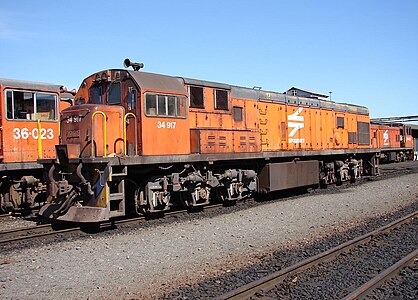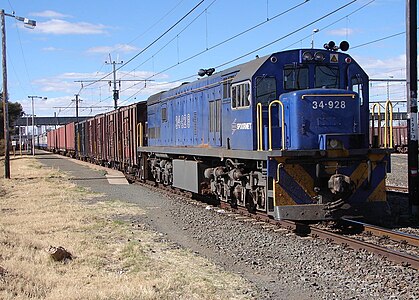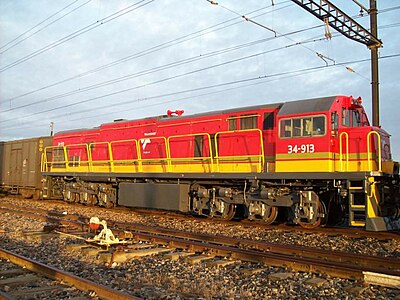|
South African Class 34-900
The South African Railways Class 34–900 of 1980 is a diesel-electric locomotive. In 1980 and 1981, the South African Railways placed thirty Class 34–900 General Electric type U26C diesel-electric locomotives in service.[1] ManufacturerThe Class 34-900 type GE U26C diesel-electric locomotive was designed by General Electric and built for the South African Railways (SAR) by the South African General Electric-Dorman Long Locomotive Group (SA GE-DL, later Dorbyl). Thirty locomotives were delivered in 1980 and 1981, numbered in the range from 34-901 to 34-930.[1][2][3][4] Distinguishing features As built, the GE Classes 34-000, 34-400 and 34-900 were visually indistinguishable from each other. The ex Iscor Class 34-500 locomotives could be visually distinguished from the other series by the air conditioning units mounted on the cab roofs of most of them and initially, when it was still a feature unique to them, by their running board-mounted handrails.[5] At some stage during the mid-1980s, all Class 34-000, 34-400 and 34-500 locomotives had saddle filters installed across the long hood, mounted just to the rear of the screens on the sides behind the cab. Since then, Class 34-900 locomotives could be distinguished from the older models by the absence of the saddle filter.[5] ModificationsFuel capacityAs built, the Class 34-900 had a 5,400 litres (1,200 imperial gallons) fuel tank and interlinked bogies, while the Class 34-500 was delivered new to Iscor with a 7,000 litres (1,500 imperial gallons) fuel tank to cope with the lack of en route refueling points on the Sishen-Saldanha iron ore line. To accommodate the larger fuel tank, the inter-bogie linkage found on all other models was omitted on the Class 34-500.[6] To be usable on the iron ore line, Class 34-900 locomotives which ended up working there were modified to a similar fuel capacity. The inter-bogie linkage was removed and the fuel tank was enlarged by changing it from saddle-shaped to rectangular box-shaped. To maintain its lateral balance, a slab of metal was attached to each bogie in place of the removed linkage. In the second picture, the weld lines on the end of the enlarged fuel tank as well as the metal slab at the end of the bogie are visible.[7]
Running board-mounted handrailsClass 34-900 locomotives which are allocated to the Sishen-Saldanha Orex line are usually further modified by having removable running board-mounted handrails installed. All South African diesel-electric locomotives have their side handrails mounted along the upper edges of their long hoods. The ex Iscor Class 34-500s, however, came equipped with additional removable running board-mounted handrails. Since these handrails are slide-fit into brackets welded onto the running board, they are easily removed.[1][5] Electronic control systemBeginning in 2010, some locomotives were equipped with electronic fuel injection and GE Bright Star control systems. On some of the first locomotives which were so modified, externally visible evidence of the modification is a raised middle portion of the long hood. All Bright Star-equipped locomotives emerged from this modification repainted in the Transnet Freight Rail livery. Service Class 34-900 locomotives work on most mainlines and some branchlines in the central, western, southern and southeastern parts of the country. Some eventually joined the Class 34-500 on the 861 kilometres (535 miles) Sishen-Saldanha iron ore line to haul export ore from the open cast iron mines at Sishen in the Northern Cape to the harbour at Saldanha in the Western Cape.[4] On the Sishen–Saldanha Orex line, GE Class 34 series diesel-electric locomotives run consisted to Class 9E and Class 15E electric locomotives to haul the 342-truck iron ore trains. Each truck has a 100-ton capacity and the trains are at least 3.72 kilometres (2.31 miles) in length, powered by mixed consists of Class 9E and Class 15E electric and type GE U26C Class 34-000, 34-400, 34-500, 34-900 and, from 2012, type GE C30ACi Class 43-000 diesel-electric locomotives. In South Africa, mixed electric and diesel-electric consists are unique to the iron ore line.[1][8][9] Works numbersThe Class 34-900 builder's works numbers are listed in the table.[2]
LiveriesAll but seven Class 34-900 locomotives were delivered in the SAR Gulf Red livery with signal red buffer beams, yellow side stripes on the long hood sides and a yellow V on each end. In the 1990s many of the Class 34-900 units began to be repainted in the Spoornet orange livery with a yellow and blue chevron pattern on the buffer beams. In the late 1990s many were repainted in the Spoornet blue livery with outline numbers on the long hood sides. After 2008 in the Transnet Freight Rail (TFR) era, many were repainted in the TFR red, green and yellow livery.[2][10] The seven exceptions, numbers 34-924 to 34-930, were painted in the SAR Blue Train livery and took the place of the five SAR Blue Train liveried Class 34-000 locomotives, numbers 34-055 to 34-059 which were then all eventually repainted in Spoornet's orange livery. Some of the Class 34-900 locomotives, numbers 34-925 to 34-927, 34-929 and 34-930, were later repainted in Spoornet's orange era Blue Train livery, while the other two, numbers 34-924 and 34-928, received the Spoornet blue with outline numbers livery.[2] Illustration
ReferencesWikimedia Commons has media related to South African Class 34-900.
|
|||||||||||||||||||||||||||||||||||||||||||||||||||||||||||||||||||||||||||||||||||||||||||||||||||||||||||||||||||||||||||||||||||||||||||||||||||||||||||||||||||||||||||||||||||||||||||||||||||||||||||||||||||||||||||||||||||||||||||||||||
Portal di Ensiklopedia Dunia







